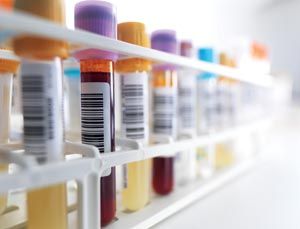Refining the Art of Arteriovenous Profiling of Blood
Researchers revisit arteriovenous profiling - comparing changes in the metabolome of arterial versus venous blood in the diagnosis of disease - using targeted and untargeted LC–MS methods.
Researchers revisit arteriovenous profiling - comparing changes in the metabolome of arterial versus venous blood in the diagnosis of disease - using targeted and untargeted LC–MS methods.
Photo Credit: TEK IMAGE/Getty Images

Profiling blood samples for biomarker discovery is a well-established technique, but often requires hundreds (ideally thousands) of samples to identify new biomarkers of disease. A new study published in Scientific Reports outlines an approach comparing the metabolite ratios in arterial versus venous blood using hydrophilic interaction chromatography coupled to mass spectrometry (HILIC–MS).1 Changes in metabolite ratios could indicate alterations in metabolism and therefore be used as an aid to diagnose disease.
This is not a new approach according to authors Julijana Ivanisevic and Gary Siuzdak who told The Column that it was first applied in early fundamental physiology studies between the 1930s and 1970s. Since then however, the power of mass spectrometry and allied separation techniques has developed massively. Metabolic profiling of blood samples using MS-based techniques is now standard practice in many clinical laboratories to diagnose diseases including diabetes and cardiovascular disease. The application of metabolic profiling in biomarker discovery is, however, somewhat limited. Small changes in metabolite levels can be masked or lost due to high inter-individual variability depending on the numerous factors, such as age, diet, and health status. Studying the paired arteriovenous ratios, within the same individual, reduces the effect of this variation.
Ivanisevic said: “We wish to stimulate the researchers to go beyond the largeâscale systemic blood screening with the focus on biomarker discovery and apply the paired arteriovenous analysis at the organ level to better characterize organ specific activity and response to different physiological and pathological conditions. Looking for disease biomarkers using the traditional venous blood draw the dilution effect is very significant, which largely explains why the success rate for identifying and validating new biomarkers has been low.”
Samples of blood were taken from a group of 20 healthy adults to compare differences in arterial and venous blood from across human forearm tissue (radial artery and brachial vein) following an overnight fast. Untargeted HILIC–MS profiling detected more than 8000 metabolite features - glutamate levels decreased and lactate increased in venous blood samples compared to arterial blood samples. Targeted profiling was then performed to determine changes in the levels of 36 endogenous metabolites using multiple reaction monitoring. Paired statistical testing was performed on each individual, as opposed to random comparison of one set of samples to another. The authors emphasize that the paired analyses was key to the success of the approach - it was highly sensitive and capable of revealing small changes.
In terms of future work, Siuzdak and Ivanisevic told The Column: “We are pursuing this from multiple angles, as you can imagine any organ that has undergone a disease perturbation could yield very interesting results. More specifically, our intention is to apply the arteriovenous approach to study the organs that are hard to access such as the human brain, for example.” - B.D.
Reference
1. J. Ivanisevic et al., Scientific Reports DOI: 10.1038/srep12757 (2015).

Regulatory Deadlines and Supply Chain Challenges Take Center Stage in Nitrosamine Discussion
April 10th 2025During an LCGC International peer exchange, Aloka Srinivasan, Mayank Bhanti, and Amber Burch discussed the regulatory deadlines and supply chain challenges that come with nitrosamine analysis.












